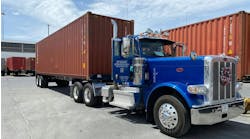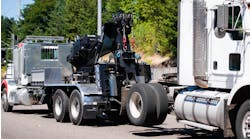Truck manufacturers aren’t the only ones girding themselves for the expected drop in truck sales next year. Carriers and dealerships alike are preparing for the long-anticipated sales decline predicated by the costly introduction of mandated emission control equipment next year. The good news is leading players indicate they expect truck demand will start to pick up before ’07 is out-- and to rise notably for two years after that.
“We expect first-quarter [2007] deliveries to remain robust followed by weaker deliveries in the second and third quarters,” said Marvin Rush, chairman of San Antonio, TX-based Peterbilt dealership chain Rush Enterprises. “However, we believe the market will begin to rebound in the fourth quarter of 2007, followed by strong markets in 2008 and 2009 as customers purchase trucks in advance of even more stringent diesel engine emissions standards that will go into effect in 2010.”
“Production of on-highway trucks should be up about 8% this year, the result of better trucking company profits and ordering in advance of 2007 emission standards,” said Jim Owen, Caterpillar’s chairman & CEO. “Truck manufacturers have covered production slots through year-end with orders.”
Right now, many carriers are still taking a “wait and see” approach to 2007, with many stocking up as much as possible on trucks equipped with 2006 engines so they won’t be among the first to put the new low-emission models into service.
“[We plan to] delay the cost impact of the federally mandated engine emission standards that are required for all newly manufactured engines beginning in January 2007,” said Clarence Werner, chairman, president & CEO of Werner Enterprises. “During fourth quarter 2006, we’ll be taking delivery of a substantial number of new trucks. And those trucks are expected to be placed in service during the first half of 2007.”
“Based on our tractor delivery schedule into early 2007, we have the ability to expand our fleet by 300 to 400 tractors with 2006 engines or to maintain our fleet’s current size,” said Randy Marten, chairman, president & CEO of refrigerated carrier Marten Transport. “Following the purchase of these tractors, we expect that our fleet age will allow us to defer any additional tractor purchases until 2008 if we desire.”
As a result of moves like Marten’s and Werner’s, production of trucks equipped with new engines will drop, leading many dealerships to stock up on trucks with pre-’07 engines to soften the projected decline in sales next year.
“New emissions standards in the U.S. and slowing freight activity should cause heavy-duty on-highway truck production to fall an estimated 40%,” said Caterpillar’s Owen. “Truck engine shipments to OEMs would fall even further.”
He said Class 8 North American heavy-duty truck sales are anticipated to decline from about 325,000 units this year to between 190,000 and 220,000 units in 2007. “The industry drop is expected to be more concentrated in the first quarter of the year, with demand increasing somewhat in the remainder of 2007,” Owen added.
“We know that there will be a sharp decline in the Class 8 truck market next year, so we began increasing our new Class 8 truck inventory during the third quarter of 2006, and expect to continue to increase it through the remainder of the year,” said Rusty Rush, president & CEO of Rush Enterprises
“[Having] A large inventory of Class 8 trucks with engines manufactured before the new emission guidelines take effect should lead to a strong start in 2007,” Rush added. “By properly managing Class 8 inventory levels heading into 2007, we hope to soften the earnings impact that will result from fewer Class 8 trucks being sold in 2007.”


